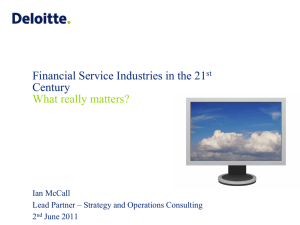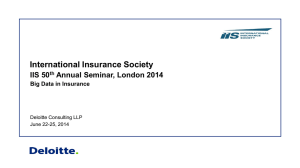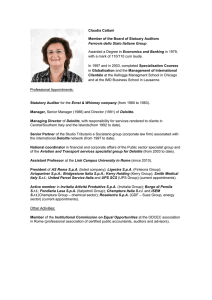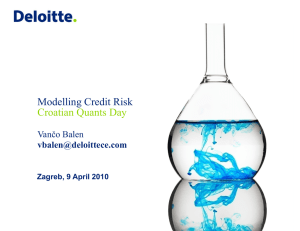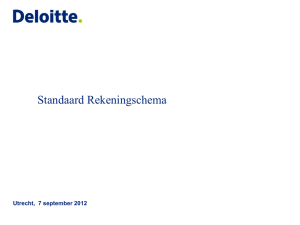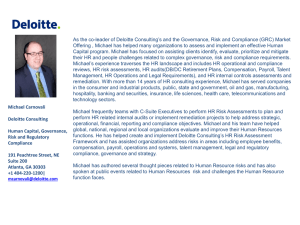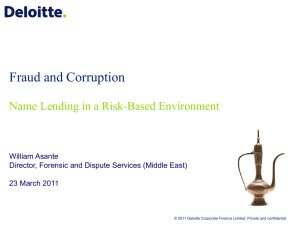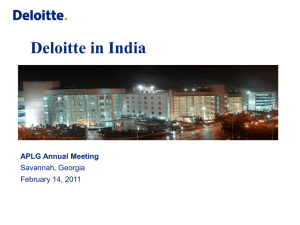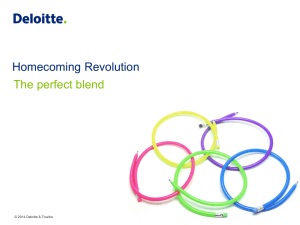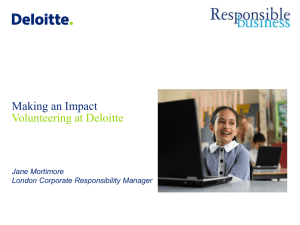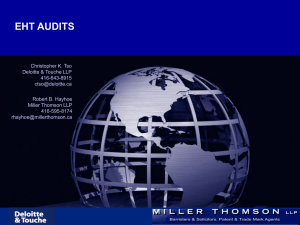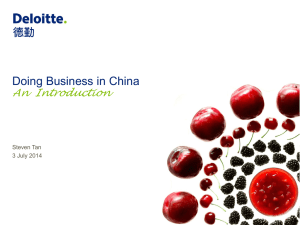Risk Management
advertisement
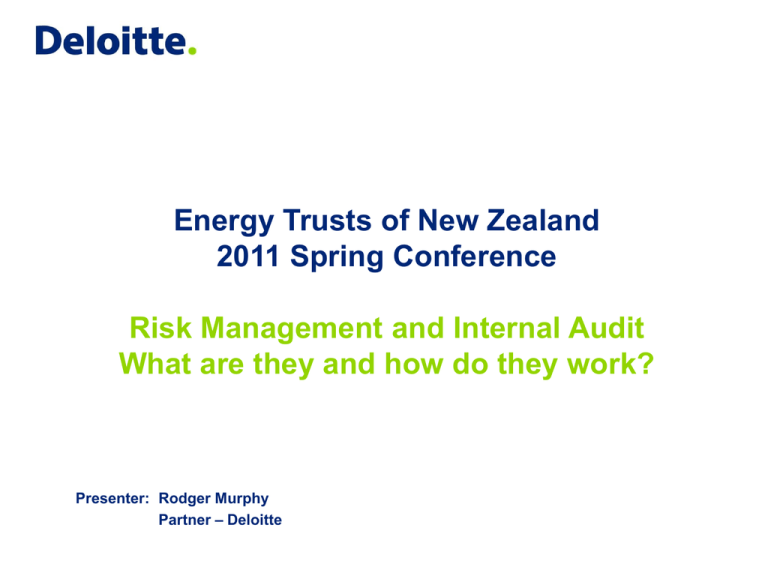
Energy Trusts of New Zealand 2011 Spring Conference Risk Management and Internal Audit What are they and how do they work? Presenter: Rodger Murphy Partner – Deloitte Areas for Discussion • Risk management - What is it? - How it works - Principles of risk intelligence • Three lines of defence • Top down approach - Risks, risk mapping, risk prioritisation, measurement - Assurance sources • Internal audit - What is it? - How can it work for your organisation • What could be included in an internal audit plan? • Some risks facing Energy Trusts 2 Strictly Private & Confidential © 2011 Deloitte. A Member of Deloitte Touche Tohmatsu Limited Risk Management • What is it: Co-ordinated activities to direct and control an organisation with regard to risk or A Process to Manage What Keeps You Awake At Night • Risk Management: A set of components that provide the foundations and Framework: organisational arrangements for designing, implementing, monitoring, reviewing and continually improving risk management throughout an organisation See diagram 3 Strictly Private & Confidential © 2011 Deloitte. A Member of Deloitte Touche Tohmatsu Limited Risk Management Process – how it works Establish context Risk identification Risk analysis Risk evaluation Monitoring and review Communication and consultation Risk assessment Risk treatment 4 Strictly Private & Confidential © 2011 Deloitte. A Member of Deloitte Touche Tohmatsu Limited Principles of Risk Intelligence 5 Strictly Private & Confidential © 2011 Deloitte. A Member of Deloitte Touche Tohmatsu Limited Principles of Risk Intelligence • Common definition of risk applied consistently • Common risk framework used to manage risks • Key roles, responsibilities and authority relating to risk management are clearly defined and delineated • Governing bodies (boards, committees) have transparency and visibility into the organisations risk management practices • A common risk management infrastructure is used to support business units and functions to deliver on their risk responsibilities • Executive management responsible for designing, implementing and maintaining an effective risk program • Business units are responsible for managing their risks • Certain functions (finance, legal, IT) are pervasive and need to support business units on risk • Certain functions (e.g. Internal audit) providing objective assurance and monitoring 6 Strictly Private & Confidential © 2011 Deloitte. A Member of Deloitte Touche Tohmatsu Limited The ‘Three Lines of Defence’ Risk Governance Model 7 Strictly Private & Confidential © 2011 Deloitte. A Member of Deloitte Touche Tohmatsu Limited Top Down Approach Understand the full picture of your organisation Take a Top Down Perspective RISKS Financial Treasury External Reputational Tax Regulatory Operational Health & Safety Strategic Assets/IT Legal Business Continuity Assurance Management Internal Audit External Audit Compliance Specialists H&S / Engineering Value Drivers Revenue Growth 8 Strictly Private & Confidential Operating Margin Asset Efficiency Management & Governance Effectiveness Execution Capabilities External Factors © 2011 Deloitte. A Member of Deloitte Touche Tohmatsu Limited Risk Prioritisation • Identify key risks in your organisation • Prioritise the top risks for Board oversight • Review top risks on a regular basis • Seek attestation from management on risks and mitigating controls 9 Strictly Private & Confidential © 2011 Deloitte. A Member of Deloitte Touche Tohmatsu Limited 10 Strictly Private & Confidential © 2011 Deloitte. A Member of Deloitte Touche Tohmatsu Limited Risk Assessment and Risk Measurement LIKELIHOOD Minor CONSEQUENCE Moderate Serious Major Catastrophic Certain H H VH E E Almost certain M H VH VH E Likely L M H VH VH Unlikely L M M H VH Highly unlikely L L L M H • Consistency • Five point scale 11 Strictly Private & Confidential © 2011 Deloitte. A Member of Deloitte Touche Tohmatsu Limited Internal Audit • What is it: Independent activity providing assurance and feedback on risks, controls and process improvement opportunities • How can it work for your organisation / trustees? - Focus is primarily on assurance - Helps protect an organisation from downside or risk and control weakness / failure - Can be used to find smarter ways of doing business – process improvement - One component of wider assurance activity 12 Strictly Private & Confidential © 2011 Deloitte. A Member of Deloitte Touche Tohmatsu Limited Effective and Value Add Internal Audit Functions • Have independence • Appropriate reporting line to the Board • Strong on risk profiling / risk based approach • Get planning at overall and individual audit level right • Apply specialist skills – e.g. Treasury, IT, modelling • Must be practical with recommendations • Input at design and build stage of new processes and systems • Recognise new and changing risk areas e.g. Modelling, IT security and automated operating environments (Scada systems) • Provides context reporting • Provides opinion on control effectiveness • Follow-up is critical on remedial actions 13 Strictly Private & Confidential © 2011 Deloitte. A Member of Deloitte Touche Tohmatsu Limited What could be included in your internal audit plan? • Links to top down risk profiling process • Identifies organisations core business processes as plan framework • Risk based • Follows organisation minimum requirements from policy/charters • Applies cycle of reviews over business processes • Provides you with a full 3 to 5 year picture of assurance reviews • Allocates sufficient budget to internal audit activity • Applies structured approach to review of IT areas (CoBiT/ITIL) • Focus on new and emerging risk areas e.g. IT security 14 Strictly Private & Confidential © 2011 Deloitte. A Member of Deloitte Touche Tohmatsu Limited Sample risks facing Energy Trusts Managing the Trust • Inadequate/ inappropriate risk management to ensure fiduciary responsibilities and beneficiary expectations are met • Key personnel risk and segregation of duties due to a small team • Succession planning for trustee role • Legislative compliance risk • Inappropriate investment decisions • Trustee disagreement • Reputation risk (non-performing assets/investments/incidence management) • Inappropriate/lack of communication to beneficiaries regarding key issues 15 Strictly Private & Confidential © 2011 Deloitte. A Member of Deloitte Touche Tohmatsu Limited Sample risks facing Energy Trusts Managing the Trust’s Assets • Insufficient technical knowledge of the business or industry risks • Regulatory Compliance • Key issues/ concerns of management unknown/ inappropriately communicated to Trust • Lack of presence/ authority on relevant business’ boards • Increased population vs. fixed payment amount (solvency risk) • Failure to appropriately distribute dividend payments - Incorrect/ duplicate payments - Fraud - Cheques not cashed 16 Strictly Private & Confidential © 2011 Deloitte. A Member of Deloitte Touche Tohmatsu Limited Questions 17 Strictly Private & Confidential © 2011 Deloitte. A Member of Deloitte Touche Tohmatsu Limited
